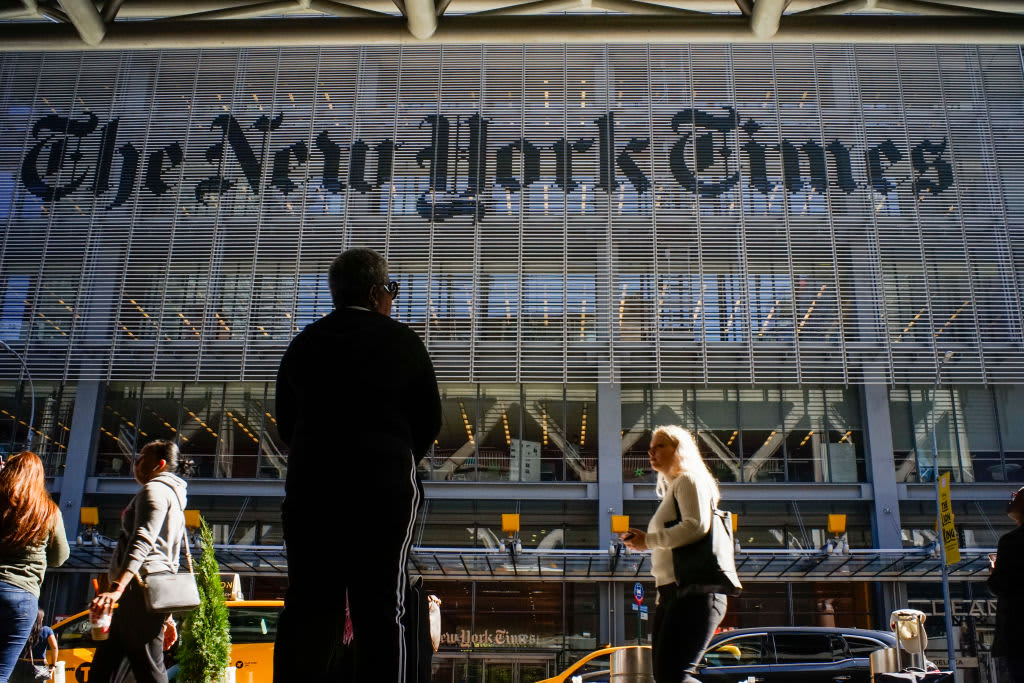People walk past the New York Times building on October 14, 2019 in New York City.
Eduardo Munoz Alvarez | VIEW press | Corbis | Getty Images
The New York Times Company said Wednesday it expects advertising revenue to fall between 50-55% year-over-year in the second quarter as impacts of the pandemic are hitting demand for advertisers. But the media company, which gets two-thirds of its revenue from subscriptions, said it added more than half a million net new digital subscriptions in the quarter.
The company’s stock rose nearly 6% Wednesday morning after reporting first-quarter earnings.
Many ad-based businesses have warned about a big impact to the second quarter because of declining demand from advertisers. Lots of online publishers in the U.S. have said advertisers are canceling or pausing ad campaigns as the coronavirus pandemic and lockdown impact advertisers.
It has resulted in widespread layoffs and cost cuts in the media world even as media consumption is skyrocketing.
The Times said it added 587,000 net new digital subscriptions compared to the end of the fourth quarter of 2019, resulting in its highest number of net new subscriptions in a quarter in its history, despite relaxing its paywall on coronavirus-related coverage. The company’s subscription revenue grew 5.4% in the first quarter to $285.4 million year-over-year. At the end of April, the Times had more than 6 million total subscriptions across digital and print, it said.
But that came as advertising started falling off at the end of the quarter. Its ad revenue in the first quarter fell 15.2% to $106.1 million year-over-year. The company’s first-quarter digital ad revenue decreased 7.9%, while print advertising decreased 20.9% as the pandemic further impacted advertisers in the areas of luxury, media, entertainment and financial categories.
And it’s expected to decelerate further: The company said it believes advertising in the second quarter will fall between 50-55% compared to a year ago “with limited visibility beyond that.”
The company said it expects subscription revenues in the second quarter to increase in the mid-to-high single digits compared with the second-quarter of 2019.
“The Times’s business model, with its growing focus on digital subscription growth and diminishing reliance on advertising, is very well positioned to ride out this storm and thrive in a post-pandemic world,” the company’s president and CEO Mark Thompson said in a statement. “We’ve seen historic audience levels and an unprecedented rate of subscriber growth as well as real pressure on advertising revenue.”
During an earnings call, Thompson said lower ad revenue will put pressure on profitability for some time and that the company is planning cost reductions, including likely job cuts. He said the company doesn’t expect any of those job reductions will be in journalism.
On the call, the company’s chief operating officer Meredith Levien said the company is expecting a pronounced downturn in advertising for at least the next quarter “and likely beyond.” But she noted the company has been working to transform its ads business and that current circumstances will hasten that. The company is working to concentrate its ads business in a smaller number of growing categories, like tech or financial services, where the NYT can build multi-platform collaborations with companies like Alphabet‘s Google or Verizon.
It’s also working on ad products based on first-party data collected from its readers. And though the company expects softening in demand for audio during a recession, it said podcast revenue in the first quarter grew 30% as “The Daily” podcast became an “even larger and more sought-after platform for our advertisers.”
